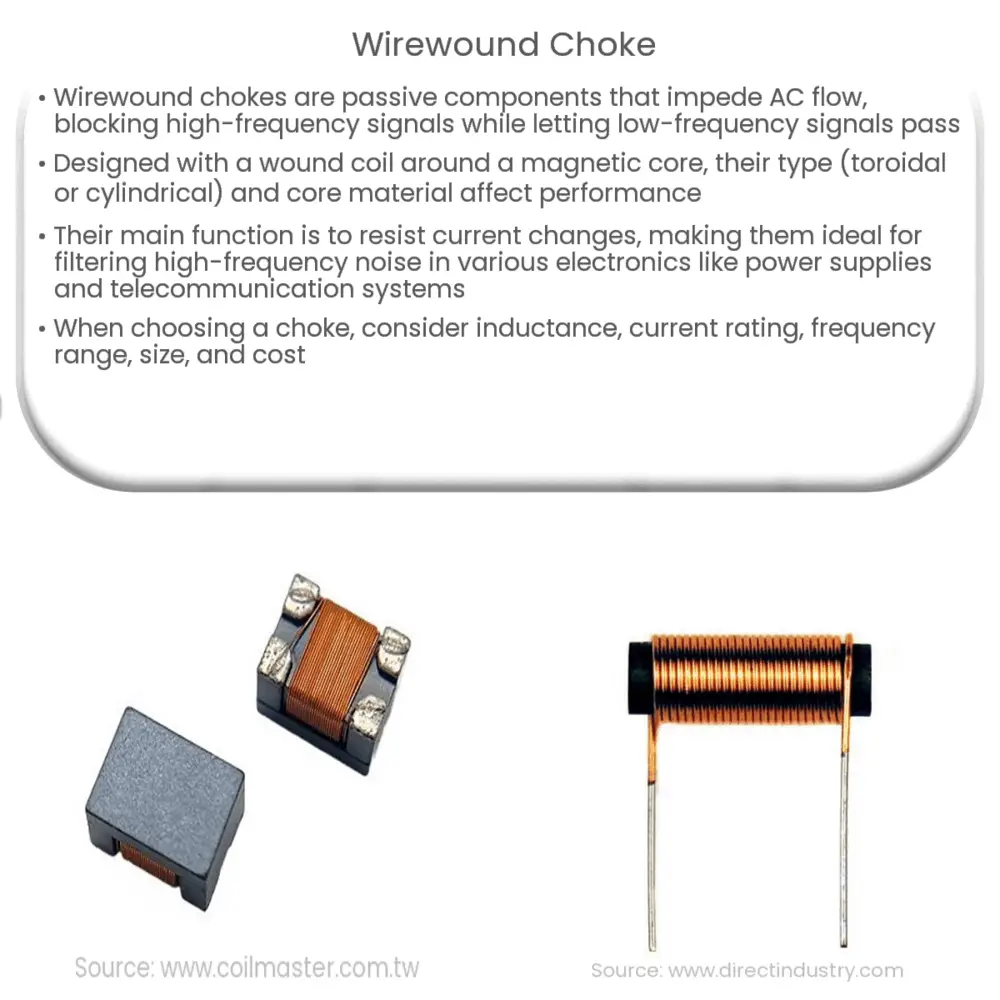A wirewound choke is a passive electronic component that filters high-frequency noise, maintaining signal integrity in various electronic devices.

Understanding Wirewound Chokes: Design, Function, and Applications
Introduction to Wirewound Chokes
A wirewound choke is an essential passive electronic component designed to impede the flow of alternating current (AC) in an electrical circuit. It is commonly used to block higher-frequency signals and provide a path for lower-frequency signals to pass through. This article discusses the design, function, and applications of wirewound chokes, highlighting their significance in modern electronics.
Design of Wirewound Chokes
Wirewound chokes consist of a wound coil of wire, often insulated with materials like enamel or polymer film, around a magnetic core. The magnetic core can be made from different materials, such as ferrite, iron powder, or nanocrystalline materials, depending on the required performance characteristics. The choice of core material and the number of wire turns determines the inductance value, which in turn defines the choke’s performance.
These chokes can be categorized into two types: toroidal and cylindrical. Toroidal chokes have a donut-shaped core, while cylindrical chokes use a cylindrical core. Toroidal chokes generally exhibit lower electromagnetic interference (EMI) and a higher inductance-to-weight ratio compared to their cylindrical counterparts. However, they tend to be more expensive and challenging to manufacture.
Function of Wirewound Chokes
The primary function of a wirewound choke is to oppose changes in current by generating a magnetic field that stores energy. This energy storage capability is called inductance and is measured in henries (H). When the alternating current flows through the choke, the magnetic field around the wire expands and contracts, inducing a counter electromotive force (EMF) that opposes changes in current. This opposition is known as reactance.
The reactance of a wirewound choke is frequency-dependent, with higher frequencies experiencing greater opposition. This characteristic makes wirewound chokes ideal for filtering out high-frequency noise while allowing lower-frequency signals to pass through with minimal attenuation. By doing so, they help maintain signal integrity and reduce the risk of signal degradation or loss.
Applications of Wirewound Chokes
Wirewound chokes find a wide range of applications in various electronic devices and systems, including:
- Power Supplies: Chokes are used in switched-mode power supplies (SMPS) and linear power supplies to filter out high-frequency noise, ensuring stable output voltage and preventing interference with other components.
- Telecommunications: In communication systems, wirewound chokes help suppress high-frequency noise in data lines, improving signal quality and reducing the risk of data loss.
- Automotive Electronics: Chokes are employed in various automotive electronic systems to filter out electrical noise generated by the engine and other components, ensuring the proper functioning of sensitive electronics.
- Consumer Electronics: In devices like televisions, audio equipment, and computers, chokes are used to reduce EMI and ensure optimal performance of these devices.
Selection Criteria for Wirewound Chokes
When choosing a wirewound choke for a specific application, several factors must be taken into consideration:
- Inductance: The inductance value determines the choke’s ability to filter out high-frequency noise. A higher inductance value generally translates to better noise suppression.
- Current Rating: The choke must be able to handle the maximum current passing through it without overheating or experiencing performance degradation. It is crucial to select a choke with a suitable current rating for the intended application.
- Frequency Range: The frequency range of the choke should match the range of frequencies that need to be filtered out. Chokes with broader frequency ranges offer greater versatility but may be less efficient at filtering specific frequencies.
- Size and Form Factor: The physical dimensions and shape of the choke must be compatible with the available space in the electronic device or system. Smaller chokes are desirable for compact applications, but they may have lower inductance values or current ratings.
- Cost: The price of a wirewound choke can vary based on factors such as the core material, manufacturing complexity, and performance characteristics. It is essential to balance cost with the required performance to ensure an optimal solution.
Advantages and Disadvantages of Wirewound Chokes
Wirewound chokes offer several advantages, including:
- High Inductance Values: Due to their wound coil design, wirewound chokes can achieve high inductance values, making them suitable for filtering a wide range of frequencies.
- Good Thermal Stability: The construction of wirewound chokes allows them to dissipate heat effectively, providing good thermal stability and ensuring reliable performance.
- Customizability: Wirewound chokes can be designed with various core materials, wire types, and winding configurations, allowing them to be customized for specific applications and performance requirements.
However, wirewound chokes also have some disadvantages:
- Higher DC Resistance: The wound wire design can result in higher DC resistance, which can lead to power loss and reduced efficiency in some applications.
- Size Limitations: Achieving high inductance values may require larger cores and more wire turns, leading to increased size and weight, which may not be suitable for compact applications.
Conclusion
Wirewound chokes are essential components in modern electronics, providing effective filtering of high-frequency noise and maintaining signal integrity. With a wide range of applications, including power supplies, telecommunications, automotive electronics, and consumer electronics, they play a crucial role in ensuring the optimal performance of electronic devices and systems. By understanding their design, function, and applications, engineers and designers can make informed decisions when selecting the right wirewound choke for their specific requirements.

